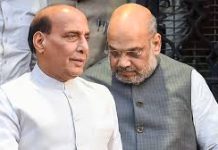
Everyone hailed NDA-II for the transparent auctions of telecom spectrum and coal blocks, which were sold for a whopping $90 billion. People felt that it was the perfect way to showcase how the Narendra Modi regime was the opposite of the previous ‘corrupt’ one, which sold natural resources for a song to the private players. Most importantly, the loyalists claimed that Finance Minister Arun Jaitley can use the auction money to hike public spending to kick-start growth.
High growth is crucial for the government to prove that it can deliver on its promises. In the past 10 months, the attitude of the poor and the middle classes towards the government has changed from bright optimism to lethargic acceptance that their lives will remain the same. However, the regime can use the tens of billions of dollars to dispel such feelings. “Achche din aa gaye (Good times have arrived),” says a BJP supporter, who added that the party’s slogan of ‘development for all’ was within its grasp.
However, most people forgot that the money from the sale to both private parties and State-owned entities will not accrue immediately, or even in the next few years. In the case of spectrum, the auction amounts will be paid over the next 12 years; the payments will be over the next three decades in the case of coal blocks. Thus, one cannot assume that the Centre will be flush with money, which it can spend in the next few years to achieve high growth rates.
The ‘Notice Inviting Applications’ (NIA) for spectrum auction laid out the payment terms and schedule. Successful bidders were given two options: payment of the entire bid amount in one go, or in a deferred manner, subject to a few conditions. Obviously, all the winners are likely to opt for the second; no one will wish to pay immediately if they have a choice to pay in instalments. For example, most of us buy our houses and cars by paying emis, even if we have to pay additional interest.
In the case of deferred choice, the winners need to pay 25-33 percent of the bid amounts — depending on whether they have purchased spectrum in the 800, 900 or 1800 MHz band — within 10 days of the declaration of successful bidders. As per the NIA, “There shall be a moratorium of two years for payment of the balance amount of one-time charges (bid amounts) for the spectrum, which shall be recovered in 10 equal annual instalments.” Obviously, interest will be charged on them.
An indicative schedule was given in the NIA. Suppose a bidder brought 1800 MHz band for Rs 1,000. It had to pay 33 percent, or Rs 330, as upfront charges. Two years later, it will need to pay 10 annual instalments of Rs 131.94 each, if the applicable interest is 10 percent. Hence, the company will actually pay a total amount of Rs 1,649.4, instead of the original Rs 1,000.
Similarly, in the case of the auction of coal blocks, the bidders will pay only 10 percent of the amount as “upfront amount”. Even this shall be payable in three instalments — 50 percent just after the auction, 25 percent within six months, and the remaining within a year. The remaining 90 percent of the total will be paid in equal instalments over the next 30 years, which is the period for which the coal blocks will be leased to both the private and State-owned winners.
What is more important is that the Centre is likely to get only a meagre portion of the $90 billion kitty. The reason: it has to share the majority with the states. Union Coal Secretary Anil Swarup told journalists, “But the central government is going to get nothing… The entire amount goes to the states. Odisha will get Rs 45,630 crore in a span of 30 years… per annum, Madhya Pradesh is going to receive Rs 1,018 crore… Jharkhand Rs 1,614 crore, Chhattisgarh Rs 1,642 crore…”
He added that while the above-mentioned and other coal-producing states will benefit by Rs 3,30,000 crore, “about Rs 69,000 crore will go in (power) tariff concessions” to the non-coal producing states. Thanks to the high bids for coal blocks and the government policy to allow power producers to ‘pass through’ or add the fuel costs to the final price, the electricity tariffs are likely to shoot up. Several power-buying states, therefore, have to be compensated in some form.
If one adds the combined monetary benefits — Rs 3,30,000 crore plus Rs 69,000 crore — to all the states, the total comprises over 90 percent of the Rs 4,40,000 crore that the government earned from the auction of the coal blocks and allocations to the public sector companies. What is left with the Centre is a mere Rs 40,000 crore, which will accrue over the next 30 years.
Jaitley hinted at this scenario in his Budget speech this February. He said, “Earlier, the states only got benefits of royalty (from their coal reserves). Now, by the transparent auction process that we are carrying out, the coal-bearing states will be getting several lakhs of crores of rupees, which they can use for the creation of long-awaited community assets and for the welfare of their people.”
This is a process that the finance minister hopes to continue. He has reiterated that NDA-II wants to increase the states’ ability to spend money directly, and at their discretion. In his Budget speech, he claimed that “we have embraced the states as equal partners in the process of economic growth. The states have been economically empowered more than ever before and it is my belief that every rupee of public expenditure, whether undertaken by the Centre or the states, will contribute to the betterment of people’s lives through job creation, poverty elimination and economic growth.”
Figures provided in the Budget documents show that of the Rs 14,49,490 crore tax revenues that the Centre hopes to earn in 2015-16, it will transfer Rs 5,23,958 crore, or over 36 percent, to the states. Compared to the previous year (2014-15), this is an over 55 percent increase, which is possibly the highest in recent times. Part of the credit for this must go to the 14th Finance Commission, which recently recommended more devolution of funds to the states.
Clearly, Modi and Jaitley feel that with more funds in their hands — through their share of the auction amounts and annual tax revenues — the state governments will spend judiciously to boost growth and development in the next few years. Only then can Modi feel confident to win the general election in 2019 and hope for a second tenure as the prime minister.
editor@tehelka.com












